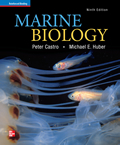
Marine Biology (Castro), 9th EditionChapter 11: Between the TidesDo It Yourself SummaryRead each sentence and identify the word/phrase that you believe correctly completes the statement. Then, click on the arrow to see if your answer is correct.1. The is the material on which an organism lives. 2. On the coast of North America, rocky shores are common only north of Cape Cod. They dominate on the coast and are practically absent on the coast. 3. Animals that live on the substrate are called . Those that burrow are called . 4. Zonation in the rocky intertidal zone is related to the difference in time at different heights. 5. Wave causes a wave to bend and become more parallel to the shore. Wave energy is focused at . 6. attach mussels to the rock. Molluscs such as , use a muscular foot. 7. usually is the most limiting resource for rocky intertidal populations. 8. Typically, the most common inhabitants of the high intertidal zone are 9. Barnacles usually occupy the uppermost part of the intertidal. Their upper limit is set by (or ); predation by (, or ) largely determines their lower limit. 10. Sea stars are called because they play a central role in the structure of rocky intertidal communities. 11. The occurrence of a regular pattern of recovery after a community is disturbed is called . Typical stages of this in the rocky intertidal are a followed by seaweeds, then , and finally (or , or ). The final stage in the process is called the . 12. The lower intertidal zone is dominated by . , as well as space, is an important limiting resource here. 13. is a relatively coarse sediment and contains little organic matter. It is found in (or ) areas. Silt and clay together are called , which is fine and organic-rich. Muddy bottoms are found in (or ) areas. 14. The most important food source for soft-bottom intertidal animals is . As a result, most are feeders. |  |















